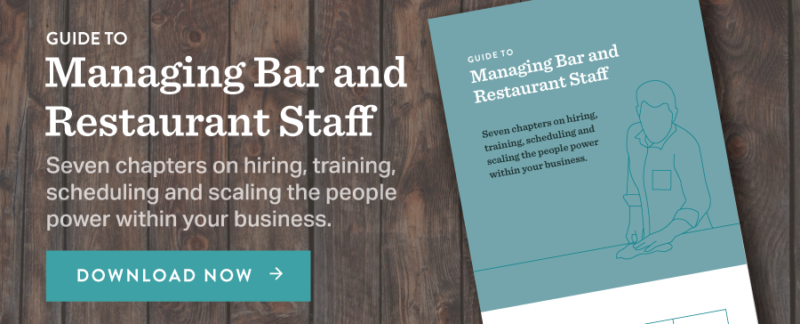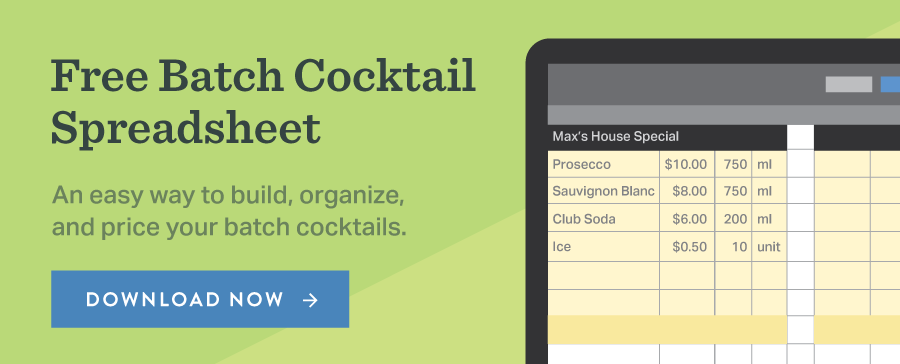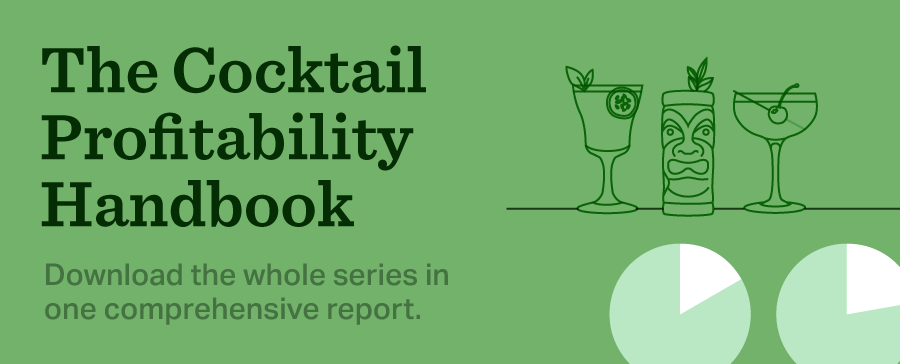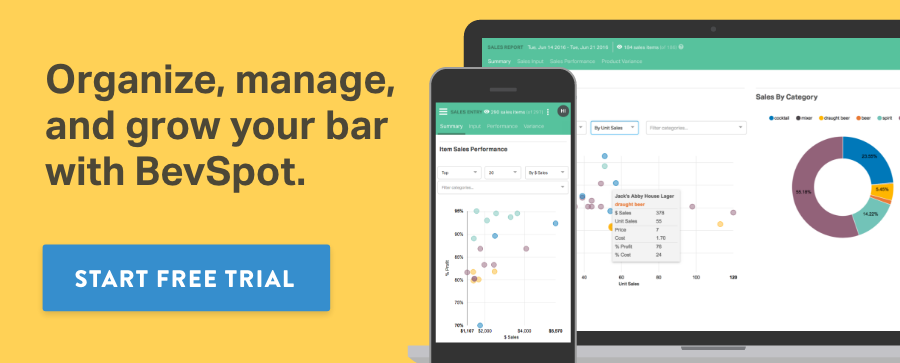16 Twitter Accounts All Bartenders and Mixologists Should Follow
Time is short for many bar staff. A constant in the industry are long nights and short mornings.
But, many an industry professional will tell you that staying up to date on the latest trends and discoveries within the world of bartending is key to holding onto relevancy in your market. Where Instagram can be a great platform to visually share cocktail ideas, Twitter can be an equally great platform to keep informed on the latest news and trends and not taking too much time to do so. 140 character status updates are generally an easier pill to swallow than longer news articles.
Here’s some bartender twitter accounts you should follow to keep on top of the latest industry happenings.
The Staying Power of Publications
For better or worse, the hospitality industry has always been well steeped in traditions. These analog tendencies have produced a staying power in books, print media and magazine publications. These places still hold a lot of weight in the bar industry and nothing proves this more than their online footprints. Some of the most influential bartender Twitter accounts are tied to industry favorite publications like Liquor (50.6K followers) and Imbibe (243K followers). Even smaller and more niche publications like Mixology (13.3K followers) and Cocktail Enthusiast (15.1K followers) have a solid following.
The influence of these publications is also naturally spread to (or, in some cases, from) their staff. Paul Clarke (11.3K followers), the executive editor of Imbibe, keeps his Twitter feed more personal, but still keeps a close pulse to the happenings of the industry. Another example is Caroline Pardilla (21.6K followers) of Eater, Thrillist, and Liquor fame.
Educational Tools and Industry Events
A huge part of the industry is the tight-knit community that is shared between all bartenders and mixologists. This shows through the community events and educational tools at bartender’s disposal. Industry events like Tales of the Cocktail (40.8K followers) and Art of the Cocktail (13.9K followers) have extremely close ties to the industry and it shows through their Twitter feeds.
Keeping up to speed in your bar education is also vital in the industry. It shows through the popularity of community hubs like ShakeStir (12.1K followers) and BarSmarts (14.7K followers).
Thought Leaders and Industry Influencers
While community is important, individuals are still celebrated amongst bartenders. Respect and reverence of someone’s hard work and innovations are a huge part of bartending culture. You can see that through the social footprints of some of the biggest names in the industry. People like David Wondrich (25.7K followers), Jeffrey Morgenthaler (15.9K followers), Dale DeGroff (22.3K followers), Jamie Boudreau (12.8K followers), and Jen Agg (12.6K followers) have all helped to push the industry and cocktailing forward.
Lastly, you can’t forget to follow Chris Mac (313K followers) for your daily inspiring quotes and fun facts to get your conversations going.
For more industry tips, make sure to subscribe to the blog below.
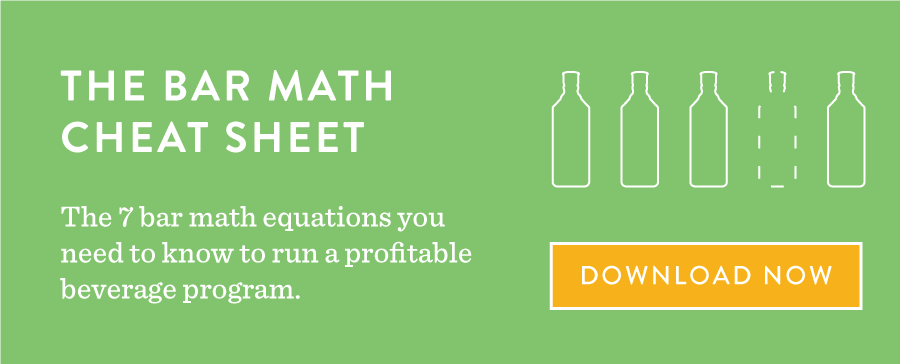
Schedule 15mins to chat with a product specialist
Start a FREE Trial Today! BevSpot offers full product education and account setup for all customers! No card Information needed!
Free eBook: Guide to Managing Bar and Restaurant’s Staff
What is it that makes the world’s best bars and restaurants truly excellent?
It’s many things, of course: the products, the pairings, the presentation, the story, the interior and even the location. But a bar or restaurant’s staff (and the care they take in creating these adventures for each guest) is usually what takes that experience to the next level.
Restaurants like Eleven Madison Park have built businesses on elevating the hospitality experience, providing a whole new level of service to their guests. To achieve this, they heavily rely on excellent staff hiring, training, organization, management and growth strategies.
Our first four eBooks focus on the process of operating a bar—from managing profitability and inventory practices to online marketing for your business.
This time, we’re putting a spotlight on the people behind the bar, the people who make up the business.
In this eBook, we explore how to effectively manage your staff members to help them excel in their roles and create that perfect service experience that’s crucial to running a successful bar or restaurant.
The 7 chapters of hospitality staff management:
- Attracting and retaining top talent
- How to properly train your restaurant’s staff
- The best staff scheduling practices for your bar
- Why your employees aren’t selling
- Why staff turnover in this industry is so high
- Growing the staff power within your restaurant group
- Some final thoughts on employee management from BevSpot’s CEO
With contributions by Donald Burns and Homebase.
Schedule 15mins to chat with a product specialist
Start a FREE Trial Today! BevSpot offers full product education and account setup for all customers! No card Information needed!
3 Things Bar Managers Shouldn’t Overlook During Black Wednesday
On Black Wednesday, preparation and efficiency for bar and restaurant managers is key.
As the year counts down to a close, the holiday season begins to ramp up for stores around the country. Thanksgiving and Black Friday are only days away, and Christmas is quickly rising over the horizon. For restaurants and bars, the unofficial opening to the holiday season comes a little sooner on what’s come to be known as Black Wednesday.
Around the country, families are gathered, college students are home for the holidays for what amounts to a winter break, and people are looking to reconnect with friends they likely haven’t seen for an extended period. All of this together adds up to a night of drinking and festivity that some bartenders and restaurateurs say rivals or surpasses New Year’s Eve and St. Patrick’s Day in terms of patron turnout and sales, potentially tripling or quadrupling regular Wednesday night business.
Being one of, if not the busiest nights of the year, it takes special preparation to make sure the night goes smoothly and successfully…
Staffing
And it all starts with staffing, and getting out ahead of the rush. First off, schedule appropriately. Anticipating the rush can help you get ahead of it, help you maintain it, and keep patrons happy throughout the night without putting undue stress on yourself and your employees. Not to mention, employees looking for a few extra hours will find ample opportunity on this busiest of bar nights. Proper staffing isn’t just ensuring that all hands are on deck and battening down the hatches. It’s making sure that the night runs efficiently, and preparing to do just that ahead of time. In the words of BevSpotter and veteran bartender Chris Bobola:
“Black Wednesday is a unique, mid-week ‘party’ where everyone is getting home for the holiday and getting the chance to see old friends. This is a night where you can expect a large showing from the younger demographic at the bars. Restaurants will see a bump for dinner, but bars will see significant traffic post-dinner.”
“A lot of this is depending on locations also. Neighborhood spots where people are coming home to will see a busy night. City spots without a large residential might not have the same type of business. Staffing based on historical numbers is a great measuring stick (meaning, look at historical performance of the establishment on Black Wednesday – provides a measuring stick for type of business you can expect). This can give you some guidance on staffing pars.
Can definitely be a wild night where monitoring your guests is important. Being proactive where you see necessary to cut people off assures you don’t lose control of the room and run into problems.”
It isn’t just making sure the staff is on hand. Preparation can be vital. Make sure that your staff communicates with one another. Know what to do in case of an emergency or upset and rowdy patrons. The better trained and prepared you and your staff are, the higher the likelihood that every holiday night is a success for you and your patrons.
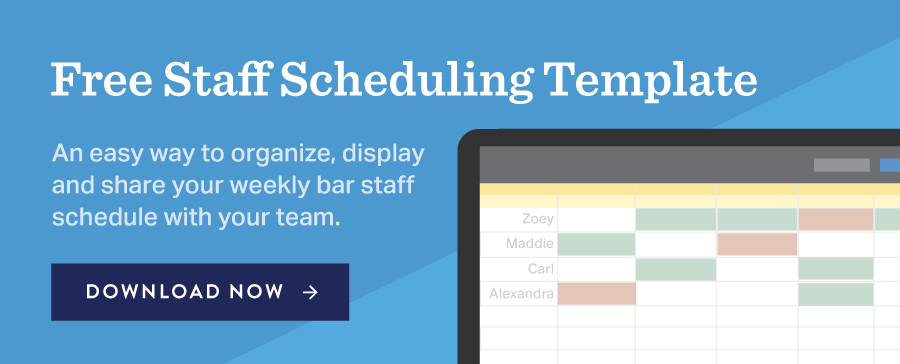
Inventory
And while it is beneficial to lay in extra staffing to manage the crowds, it will also help to avoid having to 86 your best performers later in the week. With a potentially chaotic night in the middle of the week, extra staff or an effective technology-driven solution afford restaurants and bars the ability to take a mid-week inventory not only for a potential additional order to replenish supplies, but also to take note on sales throughout the night and the holidays that follow if they don’t already.

Thus informed, savvy restaurateurs can ensure not only preparation for future Black Wednesdays but can avoid over-ordering and wasting money when in fact they could be positioning themselves for a fantastic night.
Holiday Promotions
Despite all of the potential, yet easily managed, doom and gloom, Black Wednesday and the weeks of holidays that follow are superb opportunities to turn good nights into great ones. Customers are looking to get shopping done, and are receptive to and even expecting deals and promotions while they both shop for Christmas and holiday gifts and take a break from the rush to eat, drink, and relax.
For stores that offer gift cards, these promotions offer free extras such as buy $50 get an additional $5 or $10 and double as a way to encourage more business at a later date. Taking a tip from big-box retailers, a common method is to load the bonus money onto promotional gift cards that don’t activate until after Christmas, thus encouraging repeat business, rather than having a patron buying gift cards simply to earn free money they can use immediately. Other common promotions such as buy one, get one merchandise, meals, or drinks can increase business, customer goodwill, and add on the potential for repeat business.
For all this advice, most customers don’t come to any one place for a specific drink or meal. They come for the atmosphere, the attitude, the place that they know they can enjoy themselves with friends and family before Thanksgiving, or Christmas, or whatever holiday they plan on celebrating.
A restaurant that actively plans their inventory for a busy night, and schedules and trains staff to deal with the rigors and inevitable frustrations that come with the high traffic, will find themselves in a position to not only succeed on one of the busiest nights of their year, but to thrive.
Schedule 15mins to chat with a product specialist
Start a FREE Trial Today! BevSpot offers full product education and account setup for all customers! No card Information needed!
The Future of Tales of the Cocktail: Paul Tuennerman, Part 3
(Photos courtesy of Jennifer Mitchell Photography.)
In the conclusion of our exclusive interview series with Paul Tuennerman—one of the co-founders of Tales of the Cocktail—we reflect on the past and look into the future. How will Tales and the world of cocktailing change and evolve moving forward? Who better to be asked that question than Mr. Cocktail himself?
The first part of this interview series covered how Tales of the Cocktail was born. The second part covered how Tales grew. And the finale now covers what’s next in the land of Tales, cocktailing and bartending in general.

BevSpot:
How do you feel the character of Tales has changed since it first began? Where do you hope to see it develop as it moves to the future?
Paul:
I think we’ve grown up a lot. You go back to 2006, it was Ann and me. Ann’s mom literally made every single lanyard by hand. One year, we gave out muddlers. She branded each muddler by hand. Ann’s sister was in charge of grocery shopping. Today, we have semis that back up to the Hotel Monteleone full of wines and lanyards.
We just made it work to get forward. Today, I think the team has done a tremendous job. We now have a full-time staff of ten people. We have Tales 365, our membership program. We have Tales on Tour. We have content that we’ve just started focusing on. We just did a series on mental health and well-being with Jack McGarry from Dead Rabbit who is a recovering alcoholic. He did a Facebook Live with us where we talked about his struggles in the industry with depression and alcoholism. We look at the entire industry and just give it its due and a platform for it.
We’re always evaluating what we do and how we do it. Looking for what’s next and what’s on the horizon. We definitely got to the table first for our style of event. When people ask where I see myself in five years, I always jokingly say that I don’t play that game, because that way I’m never disappointed and I’m always surprised.
We do have a vision, a mission and a set of values. We spent a lot of time writing those. If you can stay true to that, you’ll be successful. It’s when people lose track of what was important in the beginning that people start to fail.

How have you seen the trend of cocktailing grow around the world?
I grew up in the restaurant business. If you look at a trend like farm-to-table, it’s been around forever. But, it just hasn’t propagated around the country, much less around the world. There are a lot of trends in the culinary industry that have taken a long time to develop.
People have been working on open kitchen designs since the early 1990’s where they were trying to take down the walls and taking the culinary experience out front where the guest could see it, where you could see the flame and the sizzle and [experience] the smells and be part of that experience. Again, it took a long time to propagate throughout the country.
Classic cocktails are just reaching that point. I travel a lot in my line of work, about 250,000 miles a year all around the world. I’ll tell you: It has become a way better place to drink in the last decade.
Amen to that. What are your personal thoughts on trends that you’ve noticed recently in the cocktail world, whether it be at Tales or in your travels?
Whenever I travel, I try and stop by and see somebody and make a new friend. It’s interesting to see how people have started to embrace a partnership with the kitchen. Chefs tend to be very territorial. They can be dicks, let’s face it. The bartending industry is very fraternal. It’s not uncommon for people to work at two or three establishments. A chef would never have a sous chef that did that. You worked for them, you were loyal, and that’s it. You didn’t share talents across the board. So, the bartenders working in the kitchen is impressive.
Personally, I’m a huge fan of rum. Rum and agave spirits have become two of the hottest categories and both of them are favorites of mine.
It’s just really exciting to see what’s going on these days. Bartenders really aren’t wired to be business people. There’s no shortage of bars out there that have opened and closed. Simon Ford says that bartenders are struggling musicians that never bothered to learn how to play an instrument. It’s just not their forte. It’ll be interesting to see other industries come in and the role technology plays moving forward to help bartenders become better business people.
Check out the previous parts of this interview series and make sure to subscribe to the BevSpot Blog below for more insights into the industry.
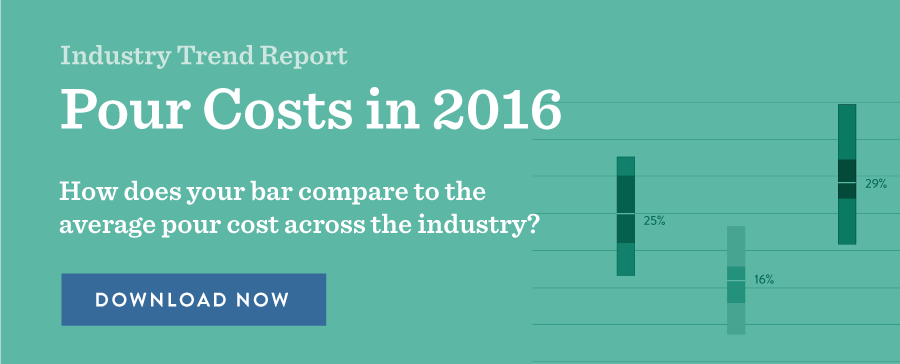
BevSpot’s Women in Tech Speaker Series: Diane Gordon
Here at BevSpot, much like the rest of the tech world, men dominate our makeup 64% to 36%. But a main focus of ours has been diversity, and we have been actively working to even out these numbers.
We see this gender imbalance in the business of the bar industry, too, but many professionals are making strong attempts to even out the playing field and hire more skilled women behind the bar. We’ve recently hired some fantastic women into senior roles here, and we proactively seek out ways to support one another. From this idea, our women in tech group was formed.
Recently, women in tech welcomed Diane Gordon, chief customer officer at Brainshark, into our office to speak to BevSpot about her experiences in the tech world.
Here’s an overview of the words of wisdom she shared with us.

Diane started her discussion with a chronological look into her professional life. This allowed us to understand what she learned at different stages of her career and how these experiences have shaped her leadership today. Diane has worked diligently to examine and adjust her priorities as she grew in her career, as she encouraged us all to do. She explained that something as small as identifying three things to work toward can provide a lot of insight and purpose into everyday professional decisions.
Diane stressed the importance of stretching ourselves; if we have aspirations to grow, we must make sure others around us know that. She encouraged us to “throw our name in the hat” for any opportunity we’re interested in, even if we know it’s out of reach. If nothing else, this lets our colleagues know where we plan on going next.
The number one trait she looks for in employees? Adaptability. For Diane, the employees who stand out are the ones who are willing to go the extra mile and pick up the responsibility of a project that’s outside their job description.
“Believe your own press” was a standout point, too.
Diane reflected on once being offered a job she felt was out of her reach; she realized, in her decision-making process, that although she might not have felt qualified, the people who hired her obviously felt she was. Diane has observed that “believing in your own press” can be more difficult for women than men, but that it’s extremely powerful once exercised.
Since Diane has worked with a multitude of people at a variety of successful companies, many of our questions gravitated toward general business and professional advice, on top of her more personal reflections.
One topic that BevSpotters wanted to hear about was communication.
We asked, “How do we educate our colleagues on how to communicate with different personality types?” Diane suggested using “’I’ statements,” for example, “when you (verb), I feel (adjective).” This allows for conversations to be had around whatever is being miscommunicated without the blame or defensiveness that often comes out of more charged and frustrated language.
Diane also encouraged us to not interrupt one another, something she’s noticed that men tend to do over women. If you are speaking and someone interrupts you, she suggests simply asking the interrupter to allow you to finish your thought before they begin speaking. Above doing this for ourselves, we can all speak up and call out interrupters for others whenever we see this behavior taking place.
As an introvert, one point on communication—err, lack of communication—that stood out to me was when Diane encouraged us all to make our voices heard in meetings. Diane expressed frustration when her employees, the people she is paying to speak up with ideas, sit quietly in a meeting. As an employee of any company, we must put our ideas out there. Diane insisted that fear of saying something “stupid or silly” should never slow us down, and, if anything, it helps to calibrate ourselves for the next time we speak up.
As a startup, we are constantly changing, growing and learning. Diane has plenty of insight on all of these topics as they apply to startups, and she helped break down a few important points for us.
First off: culture. Culture is something that has been on our minds a lot here at BevSpot, and Diane encouraged us to get together and think about what we want the culture to be, rather than just defining what our culture currently is. She also shared an important lesson she learned from her own boss when she was first intimidated by a candidate and was hesitating to extend a job offer:
“A players hire A players, and B players hire C players.”
Since then, Diane has made a point to only hire team members who she feels could one day do her job themselves.
On the opposite of hiring issues, Diane briefly discussed the need to let go of “energy vampires.” This is how Diane describes employees who are toxic. She explained that no matter what level position they hold or how much knowledge a person may have, if they’re being an “energy vampire” and stifling more than one member of a team, they’re not worth keeping.
Lastly, Diane encouraged us all to find our work-life balance. After having her first child, Diane was presented with this challenge. She overcame it by being present at work while she was in the office and present with her family once she was at home. She promised us all that our work will always be there the next morning and that it’s okay to throw it all in your desk drawer at the end of each day.
Now, Diane focuses on her most important responsibilities by prioritizing her tasks frequently. She comes to terms with the fact that the tasks at the bottom of her list will likely not be completed, but rests easy knowing that if their importance factor changes, they can always be reprioritized to the top of her list.
Diane ended our discussion with two key pieces of advice: be kind, and network.
Kindness is something that people notice, and it does pay off, whether we may realize it or not. Additionally, she challenged us all to make one networking call a week, regardless of whether we are job searching or not.
So, if you’re interested in learning more about Diane’s conversation with BevSpot or are just looking for a new connection, shoot me an email—I’ll be looking to fill my calendar with calls and coffees!
Free Batch Cocktail Speadsheet and Best Practices
Maintaining the balance between speed and quality can be precarious for bars when it comes to cocktails.
Especially when dealing with high volume, bars will often have to sacrifice either a cocktail’s quality or the ability of the bartender to get it out quickly. However, with the growing trend of large batch cocktails, the industry has found a method that helps to balance the two during the mad rushes of a service. But, how should you go about batching cocktails? How do you factor in their pour costs to the rest of your beverage program? And what problems might arise when you choose to batch cocktails?
To help you on your batching journey, we’ve released a new free cocktail spreadsheet to help track the profitability of your batched cocktails. We also chatted with a few industry professionals to get their insight into the practice:
Kate Kinsey (Bar Manager, Planter’s House, St. Louis, MO)
Her favorite house batched cocktail:
Gin Street Girl
“A fantastic whiskey sour-type drink on our new menu. We make liter-sized bottles of the spirit mixture ahead of time, then keep just the mixture on hand for service. The batch itself is a combination of 3 different whiskeys—Belle Meade Single Barrel Bourbon, High West Double Rye and Slow & Low Rock and Rye—plus Maurin Quina, a French aperitif made from cherry brandy and white wine macerated with cherries and quinine. We only combine the non-perishable ingredients in a batch, then when it comes time to build the drink, we simply pour the right amount of the spirit mixture, cinnamon syrup and fresh lemon juice into a shaking tin. Super simple!”
On the trend: “I’m all for batching cocktails. Doing so has definitely helped our bartenders deal with the higher volume times. When making a drink with six or more ingredients, often over and over, it can get tricky and time consuming.”
On the benefits: “It’s helped us with bar organization by saving precious rail space. We have 40+ drinks on our menu, and finding a spot for every bottle needed for them can be difficult. Reducing the number of bottles on the rail means we can have more of our menu’s drinks within easy reach.”
Patrick Timmis (Beverage Manager, a toda madre, Glen Ellyn, IL)
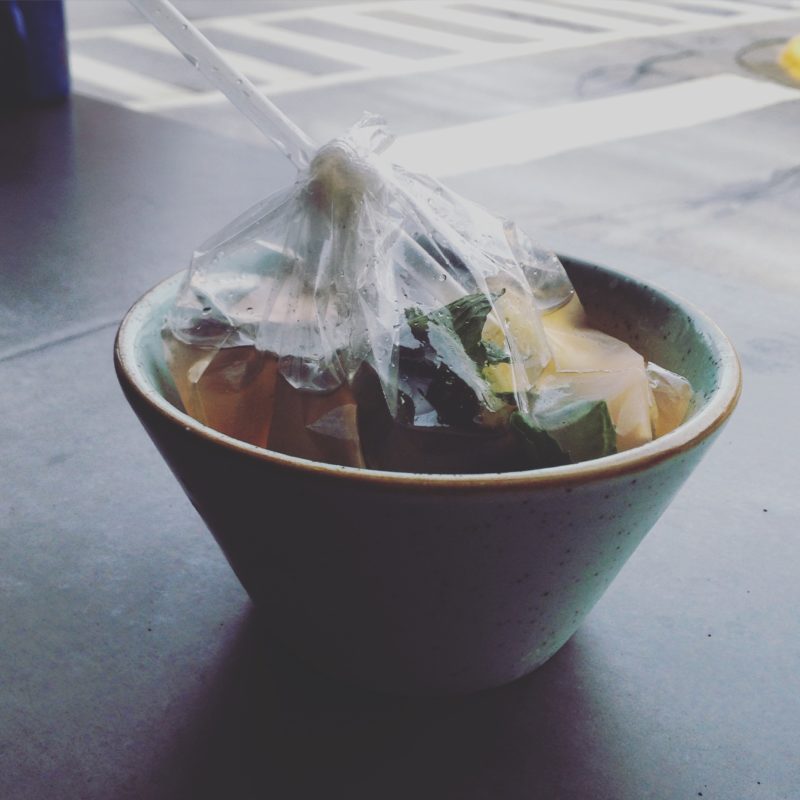
His favorite house batched cocktail + recipe:
Teporocho (slang for “street drunk” in Mexican)
-
- 40 oz Tepache (a blend of pineapple rinds/peels, piloncillo, cinnamon and cloves)
-
- 20 oz citrus mix (a blend of fresh lime juice, orange juice and sugar)
-
- 30 oz mezcal
-
- 10 oz Aperol
- 24 oz sparkling mineral water
“Fill each plastic bag with 7 oz of the above mixture, along with a couple of pineapple wedges, a lime wheel and a sprig of mint. Tie the bag around a straw, keep chilled and serve within 24 hours of preparation.”
On the trend: “I believe batch cocktails are increasing in popularity due to the ever-increasing demand for craft cocktails, without sacrificing the speed or quality of service. Customers do not want their first round of appetizers hitting the table before their drinks arrive, and batch cocktails ease the load on the bar staff during service, allowing them to efficiently send drinks out into the dining room.”
On the benefits: “These cocktails require much more preparation, which I feel is invaluable to any veteran bartender or entry-level bar back. Through batch cocktails, I am able to teach my bar staff about the importance of taste.”
On the dangers: “Batch cocktails develop over time, and knowing how they develop is so important. For example, many sangria recipes call for steeping fruit. Well, what kind of fruit will work best with the flavors we have in the sangria? How much of that fruit should we steep? How long should we steep it? Should we remove the fruit after a certain period of time or not? Will the flavor profile improve with time, or will it peak and begin to decline thereafter? These are all very important questions.”
Ray Tremblay (Reserve Brand Consultant, Diageo; formerly Beverage Manager, Craft Social Club, Miami, FL)
His favorite house batched cocktail:
Mr. Smiley Face
“It was a play on a Naked & Famous. It’s normally equal parts of mezcal, lemon juice, aperol and yellow chartreuse. I broke apart the equal parts, because it messed with the balance [of the batch]. But, I kept the same idea. Vida mezcal, aperol, a little Giffard apricot liqueur, FOS Greek Mastiha, a couple of dashes of grapefruit bitters and charred lemon juice. We would put that on a draft. It’s like, pop, put that in the coup, throw some dehydrated lemon on top, light it on fire if we have time and have some fun.”
On the trend: “I think batching is going to help restaurants be a lot more successful strictly for the fact that if you know how to cost a drink you are going to continuously do something very effective. You won’t have to worry about over pouring or inconsistency.”
His advice: “Do your research. Understand that there’s more science to it than just math. You really need to know that once you start going over a certain quantity, the ratios are going to start having to be tweaked. Understand how your bitters are going to affect it. Understand how your citrus works and oxidization affects it. Don’t cut corners. It’s not about that, and it defeats the purpose of batching. You’re trying to deliver a premium product and experience, just at a faster rate. You never want the guest to know that it’s batched.”
Need some help developing and pricing batch cocktails for your bar? Download our free batch cocktail template.
And keep it tuned into the blog by subscribing below.
Schedule 15mins to chat with a product specialist
Start a FREE Trial Today! BevSpot offers full product education and account setup for all customers! No card Information needed!
New Overtime Rules: 4 Options for Bar and Restaurant Owners
Are you ready for the new overtime law change?
You probably didn’t open a bar because you wanted to become a labor law expert. But, most likely, that’s become a big part of your job. Well, get ready for another big change: December 1st is the roll-out date for the new Department of Labor overtime regulations that will impact roughly 85% of managers in local businesses. It’s part of an update to the Fair Labor Standards Act (FLSA), and discussions around the new overtime rules have been complicated.
Here are the basics of what you need to know.
Today, only salaried individuals earning $23,660/year or less are eligible for overtime. However, on December 1st, that cap will more than double to $47,476.
In other words, any salaried employees making less than $47,476 will now be eligible for overtime.
The good news is that, with a little preparation, you can minimize the impact of these new law on your bar or restaurant’s bottom line.
As a business owner, here are four options for dealing with the overtime law change for your establishment.
Pay affected employees time and a half overtime pay
This course of action is pretty much the same thing as doing nothing. Starting December 1st, you’d just have to pay overtime for any salaried employees making less than $47,476 and working more than 40 hours. Even though it’s the easiest option requiring the least change, it may not be the best for you.
Ensure your employees work 40 hours per week or less
Most manager-level positions in the hospitality industry are full time. If you choose this option, you have to be pretty vigilant about scheduling and coverage so that your managers don’t hit overtime.
Convert your salaried employees to hourly, factoring in overtime
By converting salaried employees to an hourly wage, and factoring in overtime when making the change, business owners could conceivably pay their managers the same amount of money for the same amount of work they’re already doing, without worrying about overtime.
Check out the overtime calculator to see what your employees’ effective hourly rates would be. If you decide to go with this route, be sure you’re tracking their wage rates against others on your staff—you wouldn’t want to end up with someone feeling like they just got a pay cut.
Raise employee salaries above the $47,476 threshold
This is probably your best option for managing the wage of any employee already hovering near the new legal limit. By increasing their pay to more than $47,476, they’ll no longer be eligible for overtime, which could end up saving you money long term. At the very least, the increase will be predictable and something you can budget against. And it’s a win-win for both the business and its staff, because your employees are getting a raise.
Ultimately, while this regulatory change seems scary, it should have a negligible impact on the bottom line of most bars and restaurants around the country.
Are you implementing any of these methods, or are you planning something else to comply with the new law? Let us know in the comments.
Schedule 15mins to chat with a product specialist
Start a FREE Trial Today! BevSpot offers full product education and account setup for all customers! No card Information needed!
Home Crowd Advantage: Rachael Perry on Edmund’s Oast
Rachael Perry on Edmund’s Oast
Rachael:
Before we dive into my experience as a guest at one of my favorite restaurants Edmund’s Oast, I want to let our readers know that this will be my last blog post for BevSpot. I’ll be moving on to help the bar and restaurant industry in other ways, and I leave this wonderful source of industry knowledge in Reggie’s capable hands.
Reggie:
Thank you, Rachael. You’ve been an incredible force of mentorship and leadership in our content team. I’m sure I can speak for all of our readers when I wish you the best of luck in your future.
Getting back to the task at hand, what is a memorable experience you’ve had at a restaurant or bar?
There’s this place called Edmund’s Oast in Charleston, SC. Joe and I went down there for the Charleston Wine + Food Festival earlier this year, where I was attending events, interviewing some industry experts and writing a few articles for the BevSpot blog. Two of our good friends also live in Charleston, so we spent a lot of time with them.
Was this place a local recommendation then?
Yeah. Our friends, Tim and Bobbi, both work in the restaurant scene [in Charleston], so they know a lot of people in town. We were really taken care of and made to feel like friends.
The night before our dinner at Edmund’s Oast, we went to one of the events that was part of the wine and food festival. It was called Pecha Kucha, and it was kind of like a TED talk for the food industry. The owner of Edmund’s Oast, Scott Shor, spoke about restaurant reviews and online bullying in the form of Yelp reviews, and it was pretty funny, actually.
I feel like everybody in the industry hates Yelp. So that’s not surprising.
He came over when we were at dinner the next night, and we were all laughing about some of the review messages he’s received. During his talk, he mentioned a review card someone left him that said “YOU ARE DOOMED,” which is hilarious and awful. So we left that on our review card after our meal, too. We all had a good laugh, and it was nice to feel like we were a part of that group and that establishment.
To get more a personal connection.
Yeah.
So, when you saw the owner before, at the talk, it felt more special than a complete stranger walking up to your table.
Our friend Tim worked at Edmund’s Oast briefly, during its beginnings, so he knew the owner.
Did the owner know you were coming?
No, it was more small talk. Like, hey, my friends are in town. Here they are. Meet them.
What was the restaurant like?
Edmund’s Oast calls itself a brew pub, but it’s much more. They have this amazing beer selection, which includes even a peanut butter and jelly beer, which sounds awful but is actually not. They brew these really delicious juicy IPAs, which I like a lot. You can see the whole brewery behind these big, glass walls…
Oh, so it was like a taproom?
Yeah, they brew all their beer in the back and have part of the brewery on display behind the bar. The space sort of looks like a German beer hall, but a beautifully designed modern version. Very high ceilings. A lot of wood. Long bench tables.
Was all the beer being served their own creations?
They serve about 10 of their own rotating beers, but they offer other beers, too. Their list of sours is especially impressive, which I appreciated because sour beers are my favorite. They also serve charcuterie, which they do in-house. It’s all very nose-to-tail. And I know they’re all about partnering with local farmers and building relationships with the community through the produce they source.
Could you feel that feeling of community in the establishment?
Definitely. I think people love it because it’s such a part of the community. It’s relaxed. It’s loud. It’s fun. And the quality of food they’re serving is really high. It’s one of those local establishments that you just have to go to.
A local favorite. That makes sense. We do have a bunch of those kinds of places here, too.
We sure do.
What would you say was different there than the places here? Did anything stand out?
Nothing in particular, actually. I guess the menu is a little more Southern-inspired than anything you’d find here. But I could see a place like Edmund’s existing somewhere like East Cambridge or Somerville.
But another part of the meal that made it particularly memorable was just hanging out with these two friends who we hadn’t seen in a really long time, who we love and were having a great time with. Just hanging out at this excellent restaurant for hours and hours, eating and drinking.
Did you go to any other places that night?
Afterwards we went to a local brewery around the corner called Revelry. And then we went to this really great dive bar called The Royal American, which has great live music. It’s a little rough and a lot of fun.
That’s really interesting. I wasn’t expecting it to be so similar to here. Was there any other food that stood out to you besides the charcuterie?
The beef tartare was great. The chicken liver parfait was also great. And there were these pickled shrimp on a thin slice of dark rye bread from a local bakery called Root Baking Co. that many of the locals are obsessed with. It’s difficult bread to get your hands on, apparently. It was delicious, and as someone who sometimes bakes bread, I can really appreciate how special it is to source such a high quality product. Oh, and all of the cheese. We ordered a massive plate of it alongside the charcuterie. And the broccoli dish was a standout. Everything, actually.
Did you get to mingle at all with other people there?
We didn’t do much mingling. The staff members were awesome and super friendly. I think they came over and chatted with us every now and then, but it was mainly just us four, hanging out and catching up. Being friends.
I had a great time at the Charleston Wine + Food Festival while we were down there. But I think Charleston itself and a lot of people in the industry dislike it, because all these people come into town and it’s just such a scene.
Did you find that to be accurate? Were there a lot of snobs?
Not that I came across. There are certainly a lot of industry people: journalists, food reviewers, award-winning bartenders, some famous chefs. It’s probably pretty stressful and a long weekend for the people in the industry in Charleston. But all the spots we went to were great. Everyone was accommodating and happy to have us.
Check out Edmund’s Oast for yourself.
And make sure not to miss out on future guest perspective stories by subscribing to the blog below.
Schedule 15mins to chat with a product specialist
Start a FREE Trial Today! BevSpot offers full product education and account setup for all customers! No card Information needed!
Profitable Cocktails, Ranked by Bar Pour Cost
What’s the average pour cost for a Moscow Mule?
Here at BevSpot, we love data. Especially the kind that reveals bar and restaurant industry insights. In this case, we’re looking at trends related to the profitability of some of our country’s most popular cocktails.
Our previous analyses of bar profitability data looked at the industry’s overall profitability metrics. We found that the average pour cost, the preferred measure of efficiency for beverage programs, is around 15% for spirits and cocktails. This means that before paying wages and rent, the median BevSpot bar is getting an 85% gross profit margin on their Moscow Mule.
Actually, that’s a lie. The 15% aggregate pour cost measures general profitability for individual establishments, but it represents an average of all the various drinks being sold by those bars. Costs and pricing can vary widely between drinks, especially cocktails—the profit margin on a bar’s Negroni recipe almost certainly won’t be the same as that of an Old Fashioned.
Knowing the costs and profit margins of various recipes is critical for designing and pricing a successful drink menu. In this and a few upcoming articles, we’ll be crunching these numbers for a range of common cocktails, and we’ve turned it into a complete cocktail profitability report. To make comparing between drinks easy, we broke down these recipes based on the liquors they contain.
To find the profit margins that BevSpot users are pricing into their menus, we compared their drinks’ list prices to their unit costs before adjustments for spillage and comped drinks. We also estimated the basic cost of each recipe by comparing users’ unit costs after those adjustments. Doing this allows cleaner comparisons between each cocktail on two metrics: typical profit margins, and typical unit pour costs.
We’ve looked at sales data from nine metro areas across the United States to see which popular cocktails are the most and least profitable for bars. Here’s what we found for six vodka-based classics.
Schedule 15mins to chat with a product specialist
Start a FREE Trial Today! BevSpot offers full product education and account setup for all customers! No card Information needed!
Free Staff Scheduling Template for Bar Managers
Use this template to make staff scheduling easier.
BevSpot exists to provide you with the tools and knowledge to make your job easier, to help you save money and time so that you can get back to the parts of the job you love.
We do this in part through our bar management software, but we also strive to create free tools that the entire bar and restaurant industry can use.
Here’s our latest one.
Planning and managing staff schedules takes up a considerable amount of a bar manager or operator’s time—on average, 6.6% of their working week.
This is a large cost to hospitality businesses, so we’re making it easier with a sleek new spreadsheet. This free staffing template will help you plan, calculate, display and share your weekly bar staff schedule with your team.
This spreadsheet will allow you to:
- Enter and manage your employees’ availability
- Fill out your weekly schedule by role and shift
- Share updated schedules with your staff for easy viewing
Next up—Subscribe to the blog to receive our latest eBook: Guide to managing bar and restaurant staff.
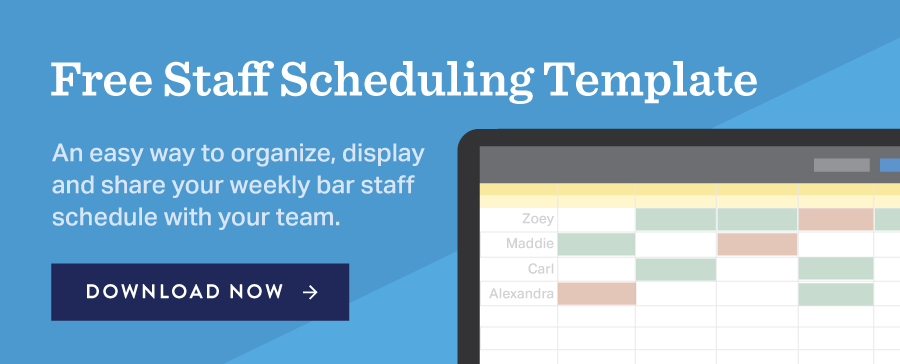
Mastering Your Bar’s Neighborhood With Train Station Pub
Everyone has their own favorite neighborhood spot. But how do you transform your place into that deep local recommendation?
The Train Station Pub recently celebrated its fifth anniversary of continued existence—an achievement that many industry professionals will understand to be a momentous one. This Canadian gastropub has been a local mainstay in the city of Kelowna, British Columbia for quite some time. Long enough to see their neighborhood change and see their own practices change alongside it.
After chatting with Dave Lindsay, one of the partners in the group that runs The Train Station Pub, we’ve compiled some tips that you can learn from their experiences to make sure your place stays a local favorite.
What is your identity?
When you’re opening a restaurant or bar, it is key to establish your identity within the local community as quickly as possible. Once people understand who you are and what you can bring to the table, the easier it will be to set incoming guest expectations and ultimately convince them to visit on a more frequent basis.
The team at The Train Station Pub really got off on the right foot when choosing their location. Building out of a surviving historic train station, the restaurant was born in an area that was very industrial at the time. Because of that, there wasn’t much competition in terms of food and beverage options in the immediate area when the the Train Station Pub was getting its feet on the ground.
“It gave us an opportunity for building roots in that part of town,” Dave told us. “It also gave us time to build the business.”
Who are your (ideal) guests?
As you build out your proverbial roots, you should be evaluating your local market along the way. What can you do to resonate more with your target audience? To connect more with their guests and feature the neighborhood they work in, the team running the bar program at The Train Station Pub made the conscious effort to feature local craft beer on their tap lines as well as locally produced wine.
There are methods you can utilize to pull the right people back, regardless of the season you’re in. In order to encourage return visits from their local audience, The Train Station Pub holds daily rotating features as well as food and drink specials, ensuring a fresh motivation for people coming back again. Frequently holding special events at your establishment, or piggybacking off of local events in the area, is another way to encourage continual patronage from your guests.
How is your neighborhood changing? (And how do you adapt?)
The Train Station Pub has been around long enough to start to see the local market change. The neighborhood has seen many of its businesses move a little farther out of the city. Because of that, the area has slowly but surely transformed into a bit of a cultural center for Kelowna. It has since added a slew of condos and competitors for The Train Station Pub.
The team at The Train Station Pub has been forced to adapt to this new competitive landscape. Depending on the roots they’ve built over time, the bar program has also gotten more effective with the addition of tools like BevSpot. With managers being enabled to lower variance, it has given them an edge over their new competitors.
You can see how BevSpot has helped The Train Station Pub keep its hold over the local neighborhood in the full story.
Subscribe to the BevSpot Blog below to make sure you’re on top of the latest industry tips and strategies. And look for more BevSpot customer stories on our newly redesigned page.
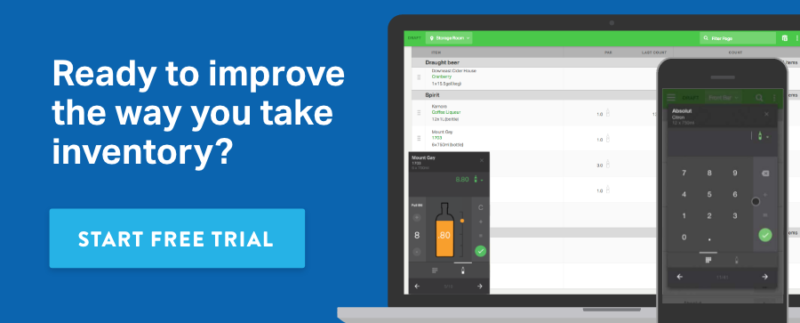
Schedule 15mins to chat with a product specialist
Start a FREE Trial Today! BevSpot offers full product education and account setup for all customers! No card Information needed!
3 Ways to Get the Most Out Of A Bar Buyout
It can be a struggle for any restaurant or bar to build a base of clientele to fill seats during slow nights and slow seasons.
With this problem in mind, a bar buyout can be a huge boon to your business. Not only does it guarantee income and feet in the door, but a successful buyout can also set up your establishment as a go-to in your community for future events.
In order for a buyout to be successful, it’s important to be as prepared as possible. There are many ways that buyouts could leave a sour taste in your guests’ mouths and kill any momentum it might have achieved in the first place. Here are a few tips to make sure that doesn’t happen.
Make It Efficient
It is undeniable that controlling the pace of a buyout is important to its success. The flow is completely different from most nights. Even on the busiest nights, people flow in and out on a more natural timing that experienced bartenders can adjust to. With a private event, however, you’re often going to run into longer lines and even more crowded bars than normal, especially at the start. This can lead to discombobulated bartenders and disgruntled guests right off the bat.
Keeping this in mind, there are ways you can combat this wave of sheer chaos. Buffering some time in between the opening of the doors and the actual start of the event can prevent immediate crowding at the bars. Having systems in place such as batched cocktails or drink tickets can also prevent the bulk ordering that tends to happen at buyouts from overwhelming your bar. For partial buyouts, having a designated area at bars for your special guests can prevent them from rubbing elbows too much against your other patrons.
Make It Special
When you host a buyout or any sort of private party, it’s always in your best interest to do something special for it. This makes the event that much more memorable for the guests coming in, which can encourage return visits outside of the event itself. This doesn’t necessarily mean having to fully build out a unique menu or crafting exclusive new items for the group coming in, but that can be a really nice touch for extra special groups or parties willing to subsidize your extra culinary and artistic efforts.
Making a buyout special can be as simple as adding custom flair to your bar decor to highlight the event. You could also look into playing personalized music playlists or radio stations crafted by the attendees. All of the details of the event, including these aforementioned logistic details, can and should be discussed and planned with the person coordinating the event beforehand.
Make It Flexible
Even with the most fleshed-out plans, most industry folks know how quickly their strategies can fully dissolve at the tip of a hat. Guests might not arrive on time, might cancel or might beg to bring along that extra friend who would throw off your count and pacing. Someone might spring a harsh dietary restriction or allergy on you when you’ve already planned out a special menu for the group.
As most industry folks know, you’ve gotta roll with the punches. If you’re not skilled at making adjustments on the fly, having fallback plans in place for these sudden changes can make your life that much easier. Making sure that the person coordinating the buyout is privy to the fallback plans is key to a smooth transition. Having them on your side when you have to make judgment calls can make your life that much easier and your chances for success that much higher.
For more tips on how to manage your bar, check out more of our blog articles in our Bar Management section. Curious about the financial details of a buyout? Subscribe to the blog below to make sure you know when we explore key elements like reconciling inventory and P&L statements when hosting a buyout.
Schedule 15mins to chat with a product specialist
Start a FREE Trial Today! BevSpot offers full product education and account setup for all customers! No card Information needed!
BevSpot Booze News: The October Roundup
It’s time for the second edition of Booze News, where we take a look at all the important bar and restaurant industry news from this month.
Reggie: Guess who’s back. Back again. BevSpot’s back. Tell a friend. (There’s my age showing.) Now that we’re firmly into the fall season, Rachael and I are back to give you another rundown of the industry news you might have missed this past month—all of the best October articles and features in one place. What more could you ask for?
Rachael: How about this ginger apple cider cocktail? No? Okay, let’s dive in.
A New Restaurant Reservation Challenger Has Appeared
Reggie: In our featured article of the month, it looks like we’re getting a fresh take on reservation software. Tock, the company co-founded by Nick Kokonas of Alinea fame, announced this month that it secured $7.5 million in funding. We’ll have to see if they can actually take on the powerhouse of OpenTable and others like Reserve, though.
Rachael: Competition in this industry continues to rise, and tech companies are racing to add additional features to their software to close out the market. Tock’s announcement came right after Danny Meyer of Union Square Hospitality Group announced that all managers and sommeliers of Union Square Cafe will start wearing Apple Watches during service. These watches will be connected to a new system called ResyOS, the newest Resy product, to manage things like reservations, table management, ticketing, web bookings and CRM.
Kings of the Bar Mountain
Reggie: The World’s 50 Best Bars were also announced this month. As expected, New York City and London were big winners and their bars dominated the list. The Dead Rabbit deservedly took the top recognition, as well as a really nice follow-up feature in CNN. I’m sure you were happy to see Sydney and Melbourne featured on the list, Rachael.
Rachael: I sure was—The Baxter Inn is my favorite whiskey bar in Sydney. I was also pleased to see Dandelyan, Ryan Chetiyawardana’s bar in London, granted third place. And we have to give a shout out to the guys over at Trick Dog in San Francisco who came in at number 35. We spoke with Josh and Scott during the Charleston Wine and Food festival, where they explained how to mix the perfect cocktail.
Are Restaurant Chains Disappearing?
Reggie: Wall Street Journal posted an article that highlights some interesting data trends in restaurants, specifically with chains. It details the recent fall of certain companies like Così Inc., Rita Restaurant Corp. and Garden Fresh Corp. Some of the explanations for these groups failing aren’t too shocking, but it will be fascinating to see how the industry adapts.
Rachael: This article says, “The U.S. is having one of its biggest restaurant shakeouts in years, as an oversupply of eateries and new rivals offering prepared meals to go claim what is expected to be a growing number of casualties.” Is this true? There’s certainly a lot of talk this year regarding the performance and stability of the big restaurant industry. Something to keep an eye on.
Instant Beer: The Beer of the Future
Reggie: Apparently, we live in the distant future and nobody told me. Off the back of the news of artificial wine in last month’s roundup, Forbes reported earlier this month about the breakthrough that To Øl, an award-winning brewery in Copenhagen, has made developing instant beer. That’s right—powder that really turns into beer.
Rachael: “The brewery, which was ranked as the 9th best in the world in 2014 by Ratebeers, worked with GEA Group to create a powder that mixes with sparkling water and distilled alcohol to mimic the taste and feel of one of the brewery’s freshly poured craft beers.” I’m not sure how I feel about this, but I’d certainly like to try it.
The Beauty of the Bartending Community
Reggie: Lastly, in the most heartwarming of local news, Boston Magazine reported on Tavern Road’s plan to honor their fallen co-founder and beverage manager Ryan McGrale who tragically passed away last year. Asking for whatever bar tools the industry is willing to send, an art installation made from the donated tools is planned to be featured on one of the walls of their bar.
Rachael: This is a perfect example of how tight the sense of community is in the bar and restaurant industry. The Tavern Road team is “asking for friends of McGrale’s, industry colleagues and anyone else who feels inspired to share spoons, jiggers, paring knives and ‘anything you want us to include in our project’ by December 1.”
Reggie: That wraps up this month. Make sure to fill in your preferred e-mail address and hit that subscribe button below for future editions of Booze News if you haven’t already.
Any thoughts on the stories you see above? Leave us a comment—let’s chat.
Schedule 15mins to chat with a product specialist
Start a FREE Trial Today! BevSpot offers full product education and account setup for all customers! No card Information needed!
Bar Staff Uniforms, and Why They Matter More Than You Think
To work in the service industry (particularly front of house) is to be seen, identified and constantly observed.
Our service style, demeanor and overall presentation are endlessly scrutinized by guests when they visit our bar or restaurant. In many ways, as hospitality professionals, we are the product being consumed just as much as the products we’re serving.
The ability to create a professional yet comfortable rapport-driven interaction with a guest, no matter their price point, is invaluable. The relationships businesses create with their patrons continues to be the driving factor in long-term guest retention. And whether we consciously realize it or not, staff uniforms—and things like a restaurant’s website or the style of your drink menu—play into this equation in an incredibly significant way.
Just as consistency in service is important, so is consistency in the appearance of service. In the same way that staff are encouraged to refrain from unflattering actions, such as running on the floor, smoking outside of the front door or shooting tequila with guests, unflattering staff uniforms can deliver a similarly incriminating message.
Beyond creating an attractive standard for staff presence, uniforms create a sense of unity within a space.
Matching uniforms to a business’ concept takes more than simply coordinating colors and textures, and smaller, more subtle minutiae of uniform design should be taken into account when considering a dress code.
It seems obvious, but the staff uniform or dress code that a bar or restaurant chooses instantly sets the tone of the space. A fine dining establishment may require all black outfits with white button-ups for servers and crisp lines all around; many establishments go so far as to ban perfume and cologne, distracting hair or makeup and jewelry across the board; and a more casual wine bar may encourage a standard of professionalism and cleanliness but lack specific “rules.”
Let’s take a look at some real-world examples of staff uniforms in hospitality.
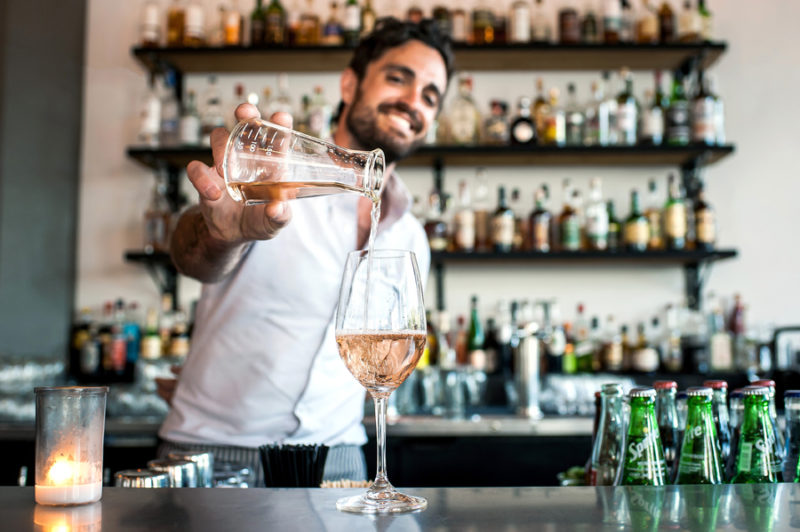
Shift Drinks in Portland, Oregon, does not require staff to wear any unifying item of clothing besides a small one-inch diameter white pin that reads “SD.” While not initially obvious, Shift Drinks’ minimalist uniform clearly reflects the smart, stylish refinement of the bar as a whole.
On the opposite side of the spectrum, Portland’s classic tiki hot spot Hale Pele encourages their staff to embrace the “Tommy Bahama” realness of their setting. Audacious floral prints, gaudy jewelry and floral hairpieces are constants. This touch not only creates a pleasing visual consistency within the space but also encourages a sense of adventurousness in clientele. Maybe I will have the flaming Coconaut cocktail today!
Chicago’s iconic Three Dots and a Dash embraces a similarly tiki-tastic uniform policy.
Cocktail bar Herbs & Rye, in Las Vegas, hits somewhere in between the laid-back chic of Shift Drinks and the over-the-top tropical feel of both Hale Pele and Three Dots and a Dash. Herbs & Rye serves classics from both pre- and post-Prohibition, and their staff uniforms play into that vibe. Black and red button-ups with matching fitted vests, ties and the occasional bowler hat vibe with the speakeasy feel of the establishment. The interplay of color, texture and style create an environment entirely appropriate for sipping the perfectly foamed Ramos Gin Fizz.
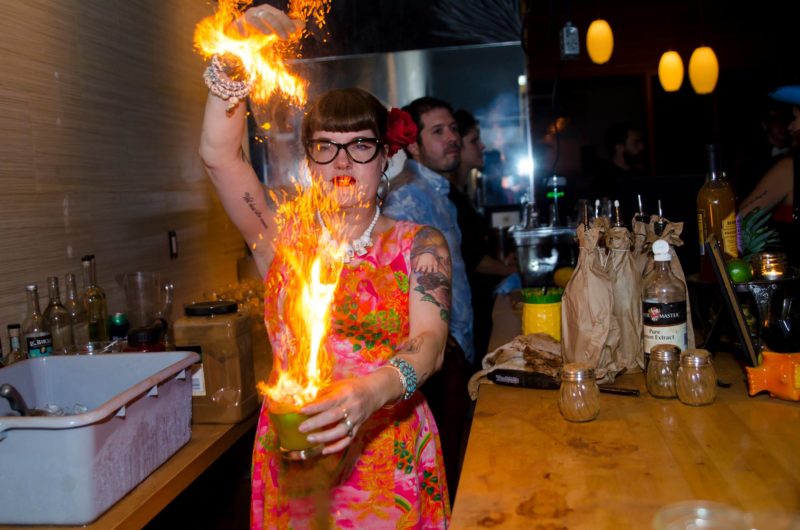
It is clear that in each of these examples the following key questions were asked (and should be asked at your own establishment when considering staff uniforms):
- Is the uniform consistent with my space and the message of my space? Both visually and conceptually?
- Is this uniform something that can easily flatter a variety of genders, body shapes and sizes?
- Does this uniform provide good range of movement for my staff and the pace of service we practice?
- Will the staff enjoy wearing this uniform or at least tolerate it?
- Is this uniform easily cleaned, or are there multiples of it?
While the idea of staff uniforms at your bar may be easily considered an afterthought, the physical presence of continuity within a space provides a sense of consistency that is invaluable. The utilitarian nature of many staff uniforms can only be upped by asking the above questions.
Careful consideration of each brand aspect of your bar or restaurant will serve to strengthen not only your brand but also its longevity.
Have a strong opinion about your staff’s uniforms? Post a photo or discuss it in the comments. And subscribe to BevSpot blog below to receive future articles about bar and restaurant industry trends.
Schedule 15mins to chat with a product specialist
Start a FREE Trial Today! BevSpot offers full product education and account setup for all customers! No card Information needed!
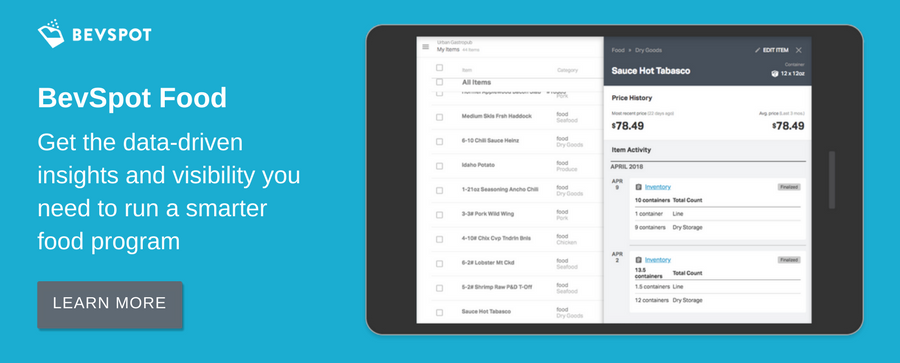
The Spirited Awards and Tales on Tour: Paul Tuennerman, Part 2
(Photos courtesy of Jennifer Mitchell Photography.)
Despite drawing massive crowds from around the world, the cocktailing festival known as Tales of the Cocktail has some deeply tangible roots within one particular area: New Orleans, Louisiana. As shown in the previous part of our interview series with Paul Tuennerman, one of the founders of Tales, the history of The Big Easy in the world of cocktailing was one of the driving factors for the creation of the festival.
However, it can be argued that a lot of the continued success of Tales can be attributed to how well it has resonated across the globe. The development of features like The Spirited Awards and Tales on Tour have contributed heavily to its growing international reach.
In the second part of our exclusive interview with Mr. Cocktail himself, we chat more about the local roots of Tales and the creation of The Spirited Awards and Tales on Tour.
BevSpot:
How instrumental was the city of New Orleans to the success of Tales? Do you think it would have worked elsewhere?
Paul:
I think New Orleans makes for the perfect backdrop for Tales. A lot of classic cocktails were created here: the Grasshopper, the French 75, the Brandy Crusta and the Beach Bum, for example. There are some natural ties to the city.
I also think the people in the New Orleans hospitality industry are very gracious and embracing. You think about the timing of the event: It’s the third week of July. In 2006, at that time, the city was empty. Let’s face it—even with air conditioning, it was hot and sticky. A lot of people also got laid off, and a lot of restaurants closed. It was just a dead year for them.
But, as the event grew, so did the businesses of everyone around us. I think they were very appreciative of that, and that they paid that back by making sure they took extraordinary care of our guests. Nowadays, a lot of bars and restaurants are busier during the five days of Tales than they are during the two weeks of Jazz Fest or Mardi Gras. It’s become a big part of their year, so they really step up. One day, the team was driving down the street and the Lucky Dogs hot dog guy flagged us down and said, “Thank you. Tales is my best week of the year, and the people that come to town tip big.”
New Orleans is a large city, but it’s really easy to get around. It’s very casual. I think it’s the perfect place for it. I don’t know if you could do it in New York, San Francisco, Chicago or LA.
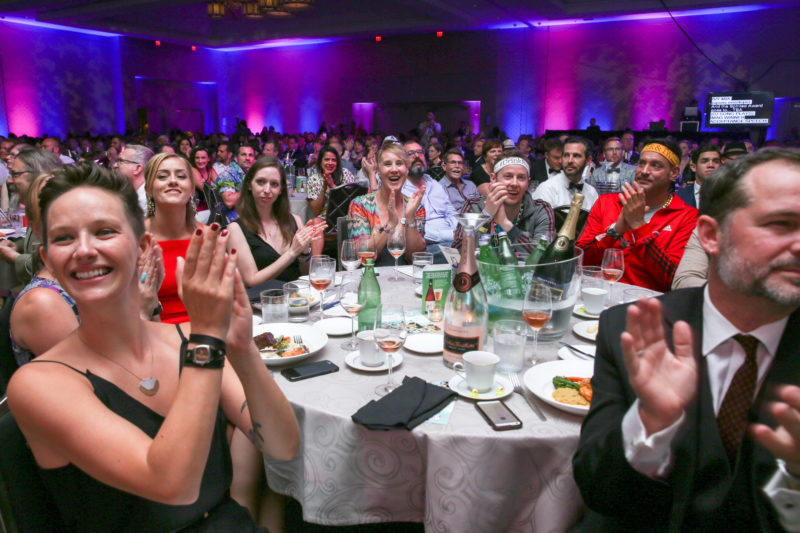
Something that has become a huge part of the industry is the Spirited Awards. What was behind the idea of that? How do you feel it differs from other industry awards?
Tales was celebrating its tenth anniversary when we came up with the Spirited Awards. If you go back, there really wasn’t anything at that time that celebrated the success of these people and brands in the industry. It wasn’t until just a few years ago that the James Beard Awards recognized cocktail bars. Nobody was doing it, and we felt like there were some leaders who were helping to push the movement forward who deserved to be recognized.
It’s kind of interesting. We were wondering if this would be important to them. Then you go to London and visit The Connaught Bar. There must be at least eight plates prominently displayed on their backbar. John Lermayer of Sweet Liberty won an award this year and sent us a note to say that he had no idea how financially impactful this was. The mayor of his community also wrote him a really nice letter to congratulate him.
The Spirited Awards can really have an impact on careers. If you look at the guys at Dead Rabbit, you’ll see how the Spirited Awards have launched them on a really nice trajectory of success. So, I think it’s relevant and they do matter. We just feel like we need to celebrate what people are doing.
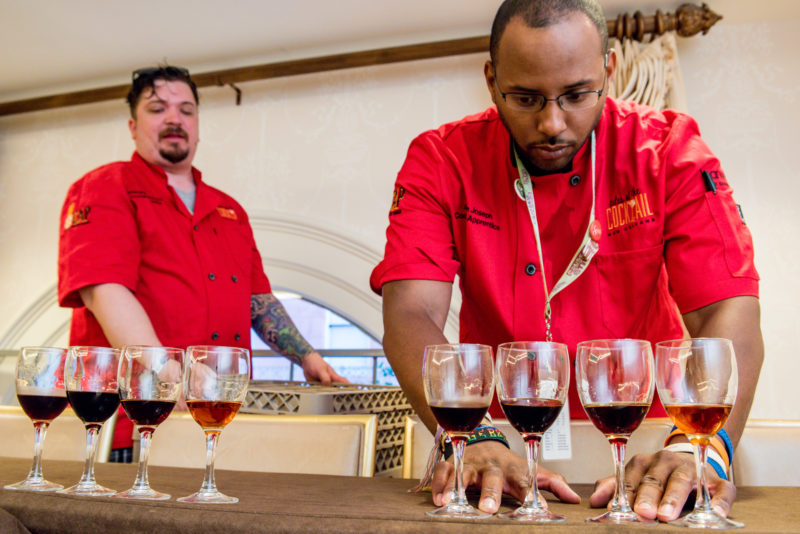
Another thing you’ve developed is Tales on Tour. Why did you choose Vancouver as the first location to do that? And are there any locations you look forward to going to in the future?
In our travels and discussions, we would find these places that are doing some rather unique and interesting stuff. We just completed our sixth year of doing Tales on Tour. Six years ago, it was really all about New York, LA, San Francisco and Chicago. Those were the only four cities on the planet. I had been going to Vancouver since the early 1990’s, because I like that they have a really robust culinary scene.
So, when we started talking about where to go to do a mini-taste of Tales, we decided to go there. They were doing tremendous stuff. Vancouver has some rather stringent laws around liquor. What that forced them to do was to get far more creative in their approach to cocktails. They spend a lot more time in the kitchen—elbow-to-elbow with the sous chef—than most bartenders do. So, we wanted to celebrate what they were doing there.
We also talk to a lot of the brands to get their opinions on the next market and the next hot scene. That’s how we ended up in Buenos Aires and Mexico City. The impact that it has is incredible. We went to Mexico City two years ago for the first time, and it was a good place to drink. But, this last time when we went, I was blown away by how fast the city came together and how many more really good cocktail programs there were.
In 2017, we’re planning to go to Edinburgh, Scotland, and we’re really excited about that. It’s really meant to be a cultural exchange. When we went to Vancouver, we brought some of the cocktail apprentices. The next year at Tales, we brought the cocktail apprentices from Vancouver to New Orleans so they could bring their insights and skills. We’ve done that with Buenos Aires and Mexico City, as well. I think that helps everybody to get first-hand experience in a unique setting.
Subscribe to the BevSpot Blog below to not miss the conclusion of this interview series.
Bar Schedules: 6 Tips to Make Staff Scheduling Painless
6 Tips to Make Staff Scheduling Painless
Let’s face it—scheduling staff is a pain in the backside for every bar and restaurant manager or owner. Some may take to it like a duck to water, but others take to it like a rhino to a jet ski (I think that idiom works).
Staff scheduling takes managers and operators multiple hours, if not days, each week to create a schedule that everyone is happy with. On average, it takes over 6.6 % of a manager’s working week to create a schedule. This is a huge cost for organizations as managers tend to be some of the higher paid employees.
Scheduling also takes large chunks of time away from the actual tasks these bar managers were hired for, such as improving processes and driving sales.
We’ve put together six simple tips to help you streamline the staff scheduling processes at your bar.
1 . Get your employees’ input
This can’t be overstated enough. Sure, there is no point in going around to each employee and asking them what days they can and can’t work, trying to suit every single one of them. But effective staff communication is the key to running a successful bar. Not only will having their input help you do this, it will improve employee morale when employees know that they have a say in the scheduling process.
Furthermore, managers will be more aware of when employees can and cannot work. In this industry, many of your staff will be college students, which means exams, project deadlines and theses. This is why open communication between staff and management is extremely necessary when creating weekly schedules. A lack of communication can lead to under or overstaffing, no shows, employee frustration and staff turnover. Let’s get talking, people!
2 . Implement scheduling guidelines for employees
Have a standardized process when it comes to scheduling. In doing this, you can lay out how often schedules will be created, what the required notice managers need for time off requests is, and also how employees should go about changing shifts with one another. This reduces confusion, and, in turn, your employees will know exactly where they stand when it comes to their schedules.
3 . Schedule in advance
For anyone who has worked in the hospitality industry, I’m sure you’ve experienced the age old problem of not knowing your week’s schedule until late Sunday night every week. This means making plans in advance is almost impossible, which will likely frustrate your employees, too.
On the flip side, creating schedules at least two weeks in advance means managers can forecast their labor costs well in advance, which will help to reduce unexpected spikes in your costs. Amendments to the schedule during the week will also not impact your employees as drastically.
4 . Stop using Excel… now
It’s plain and simple: Excel was made for numbers, not people. Sending large Excel files to each employee is time consuming, and it means every employee can see one other’s shifts for the week. This may cause friction as some employees may feel like others are getting preferential treatment when it comes to certain shifts.
Also, Excel spreadsheets don’t provide you with live data around how your bar is running from day to day, making it extremely hard to work out different financial patterns that are occurring, such as the amount of overtime worked each week.
5 . Make it easy to access
As above, when you’re creating schedules with paper and pen or excel, they tend to be published, printed out and stuck on a notice board. Employees will normally take a photo on their phones and work from there.
Sometimes, though, these pictures aren’t very legible or there’s a change in the schedules midweek. This means employees might show up for the wrong shifts or be a no-show.
There are a number of online scheduling tools that allow you to send each employee their schedule directly to their phones. For example, we here at Bizimply have a MyZimply app for employees so that their schedule is right in their pocket at all times. They can check when and where they are working and receive any schedule updates or changes.
6 . Use your schedules to reduce labor costs
There are a number of methods to do this. First, if your labor patterns aren’t reflecting your sales, then your scheduling process is broken and needs to be fixed right away. When your bar’s sales increase, your labor cost will increase, too. But what about when your sales decrease? Do you see you labor costs mirror those numbers?
This is a problem a lot of bars have. By looking at weekly and monthly data, you can identify and anticipate periods of low and high sales. Armed with this information, managers can schedule according to sales patterns and therefore reduce their establishment’s labor costs.
For more information on how to manage a successful bar, subscribe to the blog below.
Schedule 15mins to chat with a product specialist
Start a FREE Trial Today! BevSpot offers full product education and account setup for all customers! No card Information needed!
